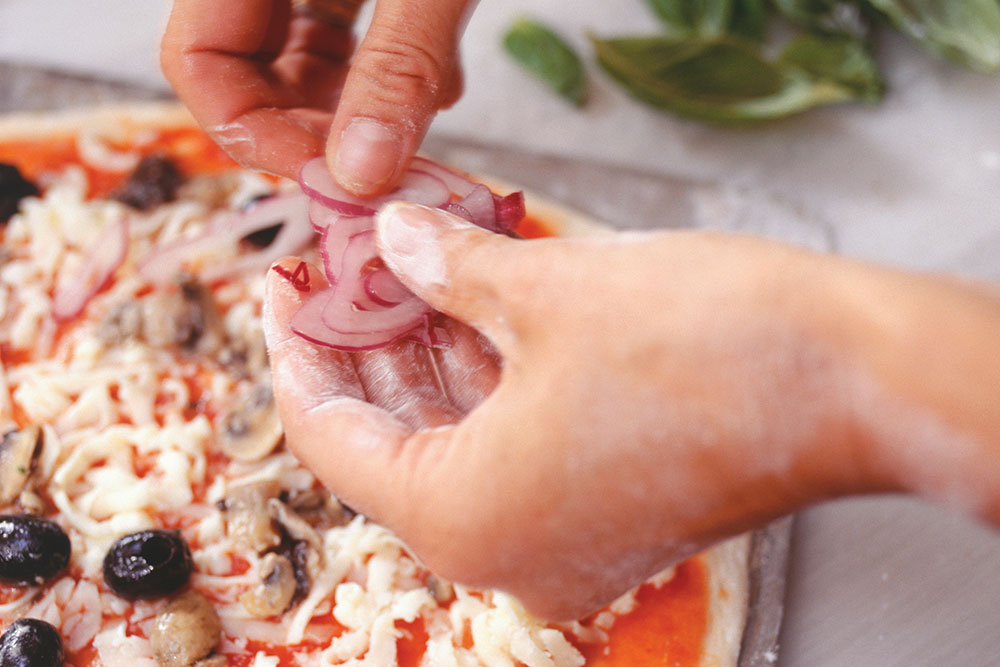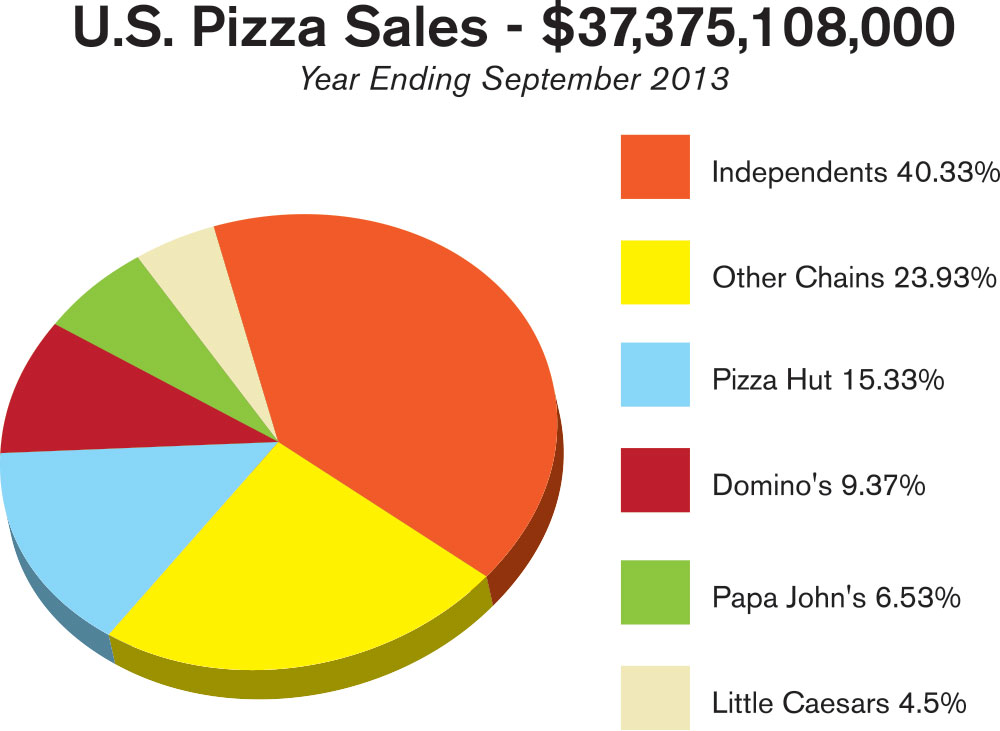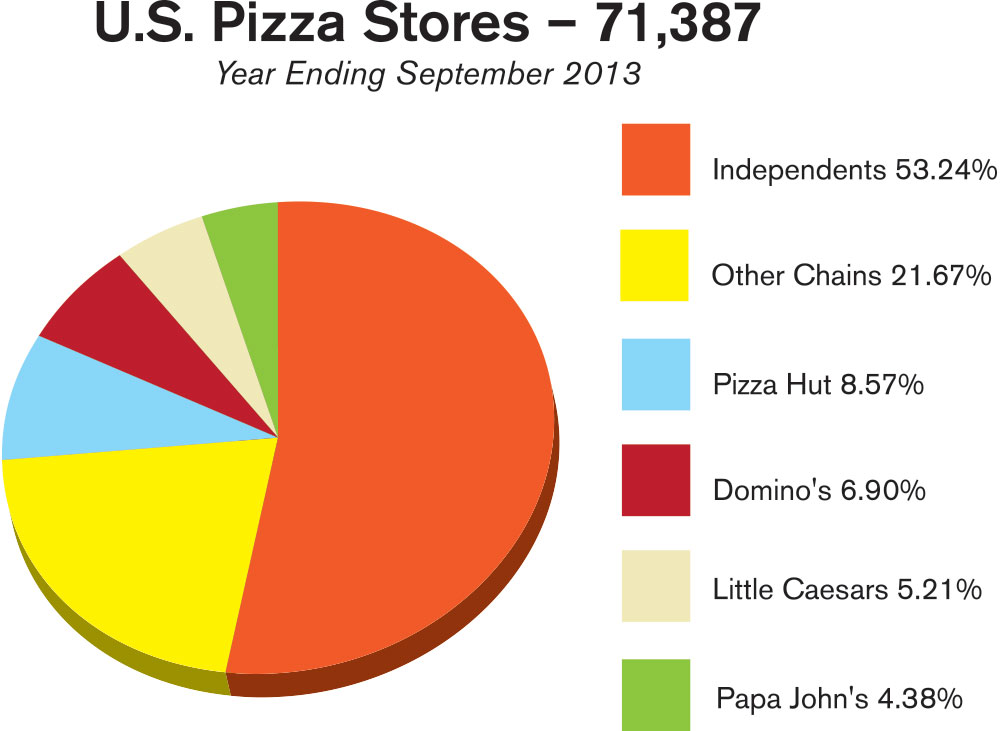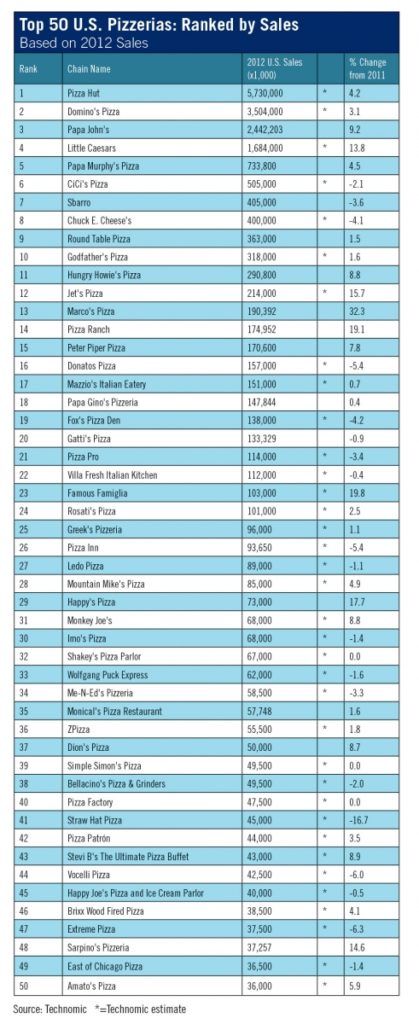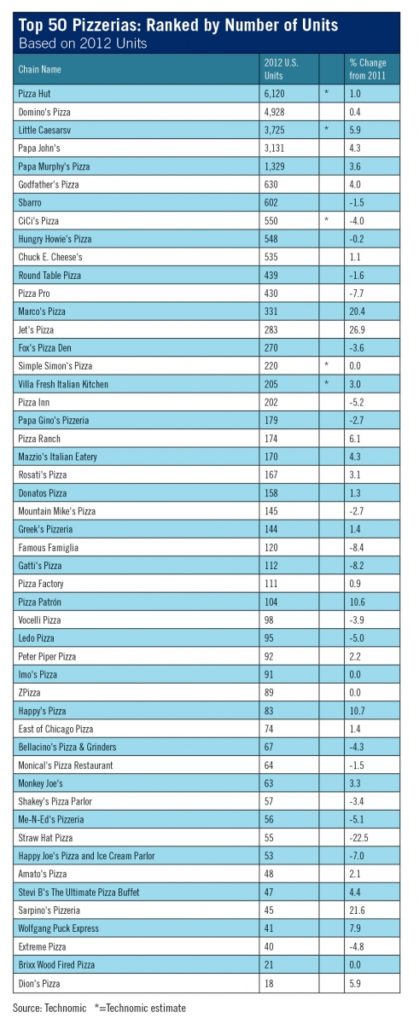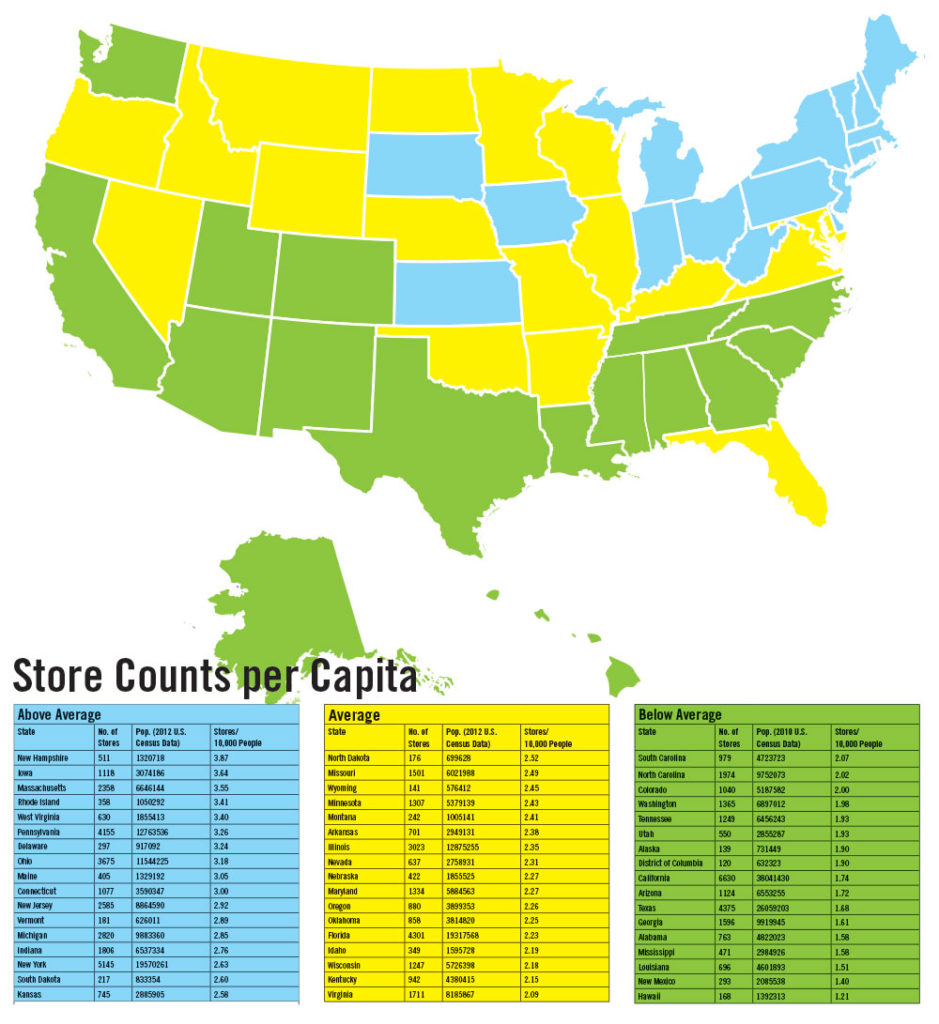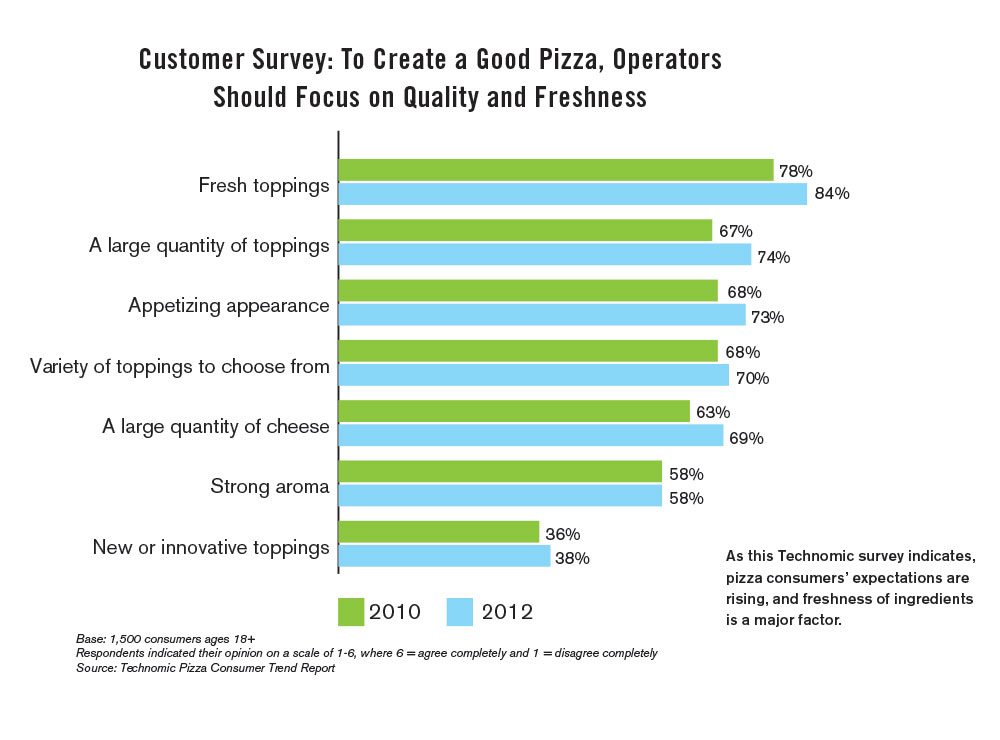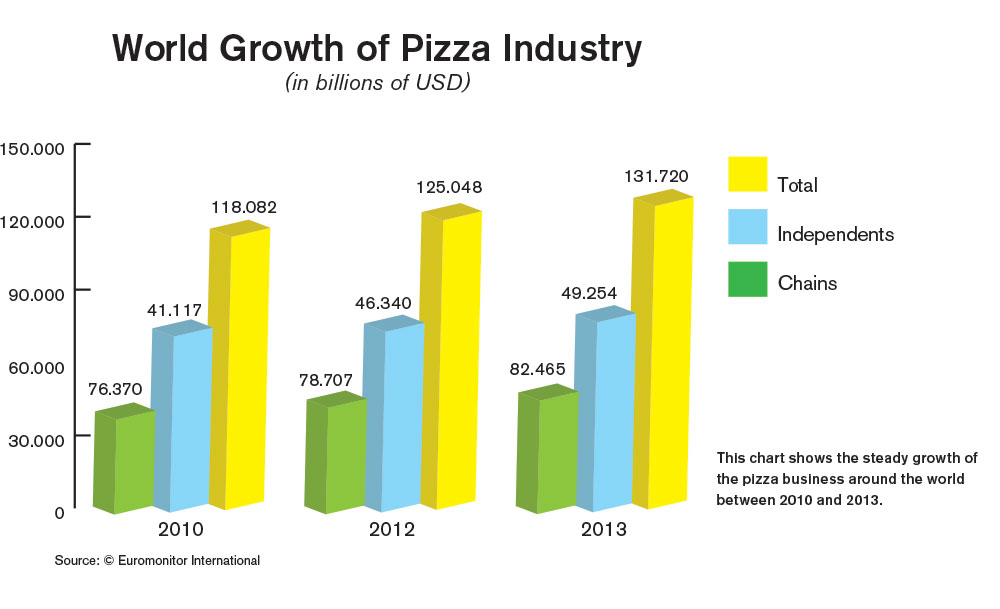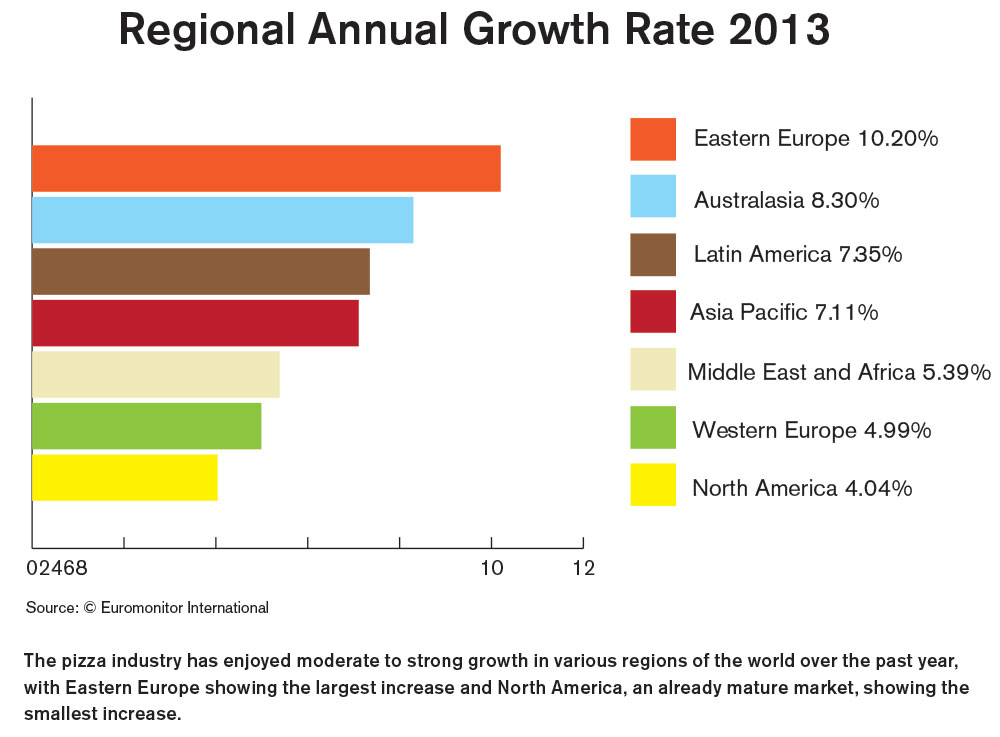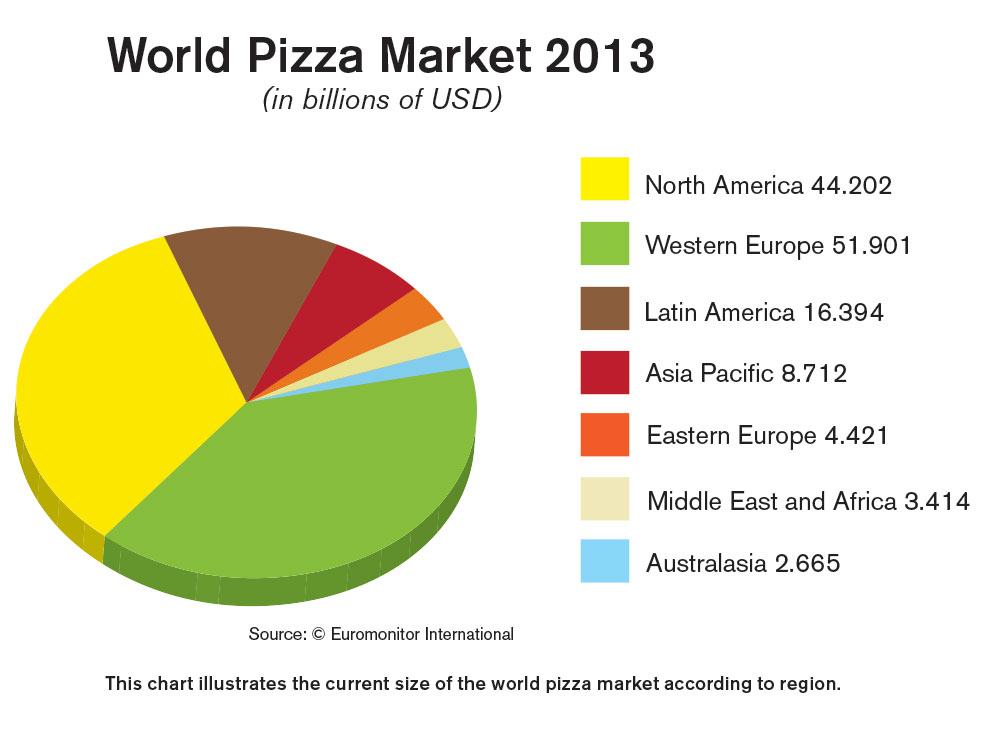There’s an invasion under way in the pizza industry. Everyone from baristas to burger chefs, it seems, wants a slice of the action. The founders of Wetzel’s Pretzels, for example, put their own twist on pizza last year with Blaze Pizza (blazepizza.com), while Chili’s Grill & Bar rolled out a line of pies and flatbreads in early 2013. Smashburger founders Tom Ryan and Rick Schaden launched Live Basil Pizza (livebasilpizza.com) in Denver earlier this year. And leading the offensive were Scott and Ally Svenson, who co-founded Seattle-based MOD Pizza (modpizza.com) in 2008 after making their fortune with Seattle Coffee Company in the United Kingdom.
For independent operators, all of these big names—and the big bucks they attract—add up to stiffer competition at the higher end of the market. But this trend also reveals something about consumers’ tastes—more discerning, increasingly sophisticated, and, yes, a little pricier than you might expect. People still like inexpensive, quick-service pizza, and they still enjoy the upscale “slow food” experience, but there’s an in-between niche—called “fast casual”—that’s ripe for exploitation. Where do you fit in?
By reviewing the past year’s overall numbers and examining the trends in some detail, the Pizza Power Report has been designed to help you plan for a more profitable 2014. We’ve culled data from a range of key industry sources, including CHD Expert, Technomic, Mintel, the National Restaurant Association (NRA), Euromonitor and RestaurantData.com. Let’s get started!
|
THE HEALTHCARE CHALLENGE |
|
Like it or not, the Affordable Care Act keeps moving forward, but its full impact on restaurants remains unclear. The White House in July delayed the employer mandate—which requires large employers to provide healthcare coverage to workers or pay a penalty—by a year, allowing businesses additional time to prepare for it. Once the employer mandate kicks in, restaurants that average 50-plus “full-time-equivalent” employees will be considered “large employers” and must offer healthcare plans to those employees or face penalties. Companies with fewer than 50 full-time employees won’t have to offer the benefits or pay penalties, but other parts of the law still apply. For example, existing healthcare plans must comply with new ACA regulations, and all employers covered by the Fair Labor Standards Act must provide written notice to their employees about government-run marketplaces. Regardless of their size, operators will need to familiarize themselves with the details of the law, including its definition of full-time employment and how to determine the status of seasonal employees or those with varying hours. They should be prepared to fulfill the law’s requirement for tracking and reporting employee data. And they’ll have to make sure they know what constitutes an “affordable” healthcare plan and what could trigger a penalty. |
Predicting Pizza
It has been particularly difficult this year to estimate the pizza industry’s growth because our sources have not been unanimous in their analyses. But after weighing a wide range of factors, PMQ is predicting a modest increase of 1.16% in overall pizza restaurant sales for 2013. Bear with us for a moment, and we’ll explain how we arrived at that figure.
Technomic’s figures indicate a sales increase of 4.75% for the Top 50 pizza chains for 2012. CHD Expert, on the other hand, showed a 2.4% decline in total pizza restaurant sales for the year ending October 1, 2013. Also weighing in on the subject was Euromonitor, which predicts a 4.04% increase in pizza sales in North America (including Canada) for 2013. PMQ also took into consideration CHD Expert’s report on the rate of pizza store openings and closings between October 2012 and September 2013. In the latter case, we have reasoned that there was not a substantial difference between the open/close rates of independent pizzerias vs. chain pizza stores for that period of time—both chains and independents added and lost stores at a roughly equivalent proportion. Finally, we also factored in data submitted by industry researcher Keith Gellman from RestaurantData.com. His research shows that, as of November 1, 2013, there had been a record number of pizzeria openings. Additionally, Gellman’s data shows that pizza store openings have increased by an average of 13% per year since 2011. Gellman also estimates that nearly 10% of all restaurant openings are now pizza concepts.
With these positive projections in mind and since the increase in the Top 50 chain sales would strongly suggest a roughly equal increase in independent sales, the staff at PMQ is splitting the difference between the reports of CHD Expert and Technomic, thus arriving at our prediction that, when all the numbers come in, total pizza industry sales in 2013 will have grown by 1.16% compared to 2012.
So what’s our final total? By our estimates, total sales for the period ending September 2013 amount to $37,375,108,000. We derived this sum by taking last year’s total sales of $36,786,524,044 (according to CHD Expert) and factoring in our estimated growth figure of 1.16% over the past year.
Store Counts and Averages
We have used CHD Expert’s data relating to total store counts. The total number of stores, according to these figures, is 71,387. About 53% of all pizza stores are independents, while 47% are chains. (For the record, we are defining independents as pizzerias with fewer than 10 units; any company with more than 10 stores is referred to as a chain.)
According to our calculations, based on CHD’s total number of pizza stores and our estimated total sales figure for 2013, the average per-unit sales for all U.S. pizzerias (chains and independents combined) equaled $523,556, compared to $511,948 in the previous year.
According to CHD, the chains’ total sales amounted to $22,301,349,410 in 2013. The chains’ average per-unit sales equaled $668,125 in 2013, an increase from $653,859 in 2012.
According to PMQ’s estimates, independent pizzerias’ total sales amounted to $15,073,758,590, compared to $14,557,100,260 in the previous year. The average annual sales for independents amounted to $396,594, compared to $380,111 in the previous year.
Finally, the total sales for the Top 50 pizzeria chains in 2012 was $19,753,075,000, with per-unit sales averaging $721,995 (among 27,359 units), according to Technomic. In 2011, the Top 50 sales equaled $18,472,166,000, with total per-unit sales averaging $653,859 (among 28,251 units). That means the Top 50 experienced a total sales increase of nearly $1,280,909,000, while store counts fell by 892 in 2012.
The Cold War
The economy appears to have hit a “sweet spot” as far as the pizza restaurant business is concerned. While the recovery has been slow, it’s been strong enough to make pizza more attractive as an affordable dining-out option, while the frozen pizza segment, according to Mintel, has declined by 1.1%. Mintel projects that frozen pizza sales will continue to drop through 2018 “as consumers rediscover their spending power and open their wallets for food away from home.” According to a survey of 2,000 pizza-eating households released by Mintel in July 2013, consumers cited taste and healthfulness as barriers to frozen pizza growth. Mintel also states that, although black consumers and families with kids are more likely to eat frozen pizza, these two groups will likely grow only modestly between 2013 and 2018.
Overall Restaurant Growth
On the whole, the restaurant industry continues to enjoy modest growth and is the nation’s second-largest private-sector employer, according to NRA research. The NRA projects restaurant-industry sales of $660.5 billion for 2013, an increase of 3.8% from 2012’s figure of $636 billion and equal to 4% of the U.S. gross domestic product. This was the fourth straight year that sales went up for the restaurant industry. Meanwhile, restaurant job growth in 2013 continued to outpace national employment growth for the 14th straight year, adding jobs at a projected rate of 2.4% and topping the national rate of 1.5%. Nearly 10% of American workers—or 13.1 million people—drew paychecks from the restaurant industry in 2013. The NRA also reports that the restaurant industry is expected to add 1.3 million jobs over the next decade for a total of 14.4 million by 2023.
The “Better Pizza” Movement
Pizza, the old joke goes, is like sex: When it’s good, it’s great, and when it’s bad, it’s still pretty good. Fortunately, with the rising popularity of artisan pizza, bad pies are getting harder to find. Many consumers today simply demand more from pizza makers, and pizzerias have stepped up to the challenge. It’s all part of the so-called “better pizza” movement, which has kept pace with the “better beer” and “better burger” trends. Cheap and basic often just doesn’t cut it anymore. The freshness of farm-to-table ingredients creates the perception of a healthier pie, while exotic cheeses and meats—think Gruyère and sopressata—convey an aura of sophistication and provide a new experience in flavor profiles.
“The consumer is really starting to figure things out, and everybody’s looking at quality,” says Scott Wiener, owner of Scott’s Pizza Tours in New York. “In part, I think that’s because the consumer base is more educated today. People know more about what they’re eating. When they walk into a pizzeria now, they’ll ask you if you’re using San Marzano tomatoes or buffalo mozzarella cheese.”
| Ethnic Flavor Trends |
| According to research firm Technomic, ethnic flavors are coming to the fore in the pizza industry, including:
Thai Breaker—Top That! Pizza offers this Thai-themed treat, made with Thai peanut sauce, whole milk mozzarella, marinated chicken, roasted garlic, caramelized onions, chopped scallions, julienne carrots, sharp cheddar and roasted peanuts. Jamaican Jerk—A popular specialty pie at Uncle Maddio’s Pizza Joint, this exotic pizza features tomato-basil sauce, mozzarella, grilled jerk chicken, red onions, green peppers, pineapples and cilantro. Athenian—Pie Five Pizza Company serves up this thin-crust Greek pizza with Italian herbs, fresh garlic, chicken, Kalamata olives, red onions, banana peppers, crumbled feta, fresh basil, sun-dried tomatoes and a mozzarella/provolone blend. |
Aging baby boomers also play a role, helping to fuel the “better pizza” movement with their higher expectations, refined tastes and disposable cash. Born after WWII, they were the first generation of Americans to grow up on pizza, and, unlike their parents who had to pinch pennies in the Great Depression, baby boomers will typically pay more for higher quality, although good value remains important to them.
In general, most consumers haven’t let a sluggish economy get in the way of pleasing their palates; if anything, they’re getting pickier about quality. In a 2012 survey by research firm Technomic, 34% of diners said they were willing to pay more for gourmet ingredients, compared to 26% in 2010, while 27% said they’d shell out more for natural or organic ingredients, up from 21% two years earlier. In the same study, 33% said they were “interested in trying pizza with highly innovative toppings,” a big jump from 13% in 2010.
“I think people are still holding back on their dining-out budgets, but they see an upscale pizza as a better value than a midscale steakhouse or seafood,” Wiener notes. “A high-end pizza is still quite affordable—the high point is probably about $22 for a personal pizza. And that’s still pretty inexpensive when you’re comparing an entrée at a nice restaurant.”
For proof of artisan pizza’s growing popularity, look no further than the country’s largest chains, including Domino’s (dominos.com), which leapt into the market a couple of years ago and offers such selections as the Chicken & Bacon Carbonara, the Tuscan Salami & Roasted Veggie and the Spinach & Feta. Meanwhile, take-and-bake giant Papa Murphy’s (papamurphys.com) tested a premium line of pizzas made with gourmet ingredients ranging from fennel sausage and goat cheese to prosciutto and arugula.
Power to the People
As buzz phrases go, “fast casual” doesn’t really say much. It fails to capture the essence of a movement that is rapidly transforming the national pizza scene, with concepts such as Blaze Pizza, Project Pie (projectpie.com) in San Diego and Las Vegas, Social Life Pizza (sociallifepizza.com) in San Diego, and 800 Degrees (800degreespizza.com) in Los Angeles leading the way. For that reason, many operators prefer terms like “customizable” and “build your own” to describe this red-hot business model. Based on the Chipotle Mexican Grill/Subway paradigm, these stores put the customer in the driver’s seat. Proceeding along an assembly-line station, guests can design their own pies from the crust up, selecting from a plethora of toppings and sauces, requesting a little more of this, a little less of that. Super-hot ovens bake the pies in just a few minutes, and the price often remains the same for any combination of toppings, typically in the $7.50 range.
With locations in Oklahoma, Texas, Colorado and the United Arab Emirates, Top That! Pizza (topthatpizza.com) has been on the forefront of the fast-casual trend since its first store opened in 2010. “People are very interested in what goes into their food these days, and feeling like they finally have the power to create a pizza of their own has made this new category very popular among just about every demographic out there,” says Top That! co-founder Lori Walderich. “Guests can see their pizzas being made and know exactly what’s going on top of it. The perceived value of the pizza is higher, along with customer satisfaction, as opposed to typical delivery or commodity pizza.”
James Markham has helped launch three different fast-casual concepts, including MOD Pizza (modpizza.com) in Seattle, Pieology (pieology.com) in Southern California and the aforementioned Project Pie. “I think it’s universally appealing,” he says. “People want to be able to get it the way they want it. You can’t get it exactly the way you want it when someone’s making it in the back kitchen.”
What took pizzeria operators so long to come up with the idea? “As we were developing Top That! Pizza, we were wondering the same thing,” Walderich says. “One possible reason is that pizza operators over the years have been afraid of losing money due to the assumption that guests would overload their pizzas with too many expensive ingredients. Or perhaps they just flat-out didn’t think of it since pizzas have been done the same way for all these decades. So many pizza places focus on delivery, convenience and cheap pricing and achieve a good level of profit, so why change?”
Technological advances helped pave the way, too, Walderich observes. “There have always been wood-fired ovens that can cook pizzas in as little as 90 seconds. But the advent of the Turbo Chef ultra-fast impinger oven really set things in motion because of its ease of use and affordability.”
You know an innovative concept has broken through to the mainstream when the big chains hop on the bandwagon. Dallas-based fast-casual eatery Pie Five Pizza (piefivepizza.com) is a Pizza Inn Holdings company, while Sbarro (sbarro.com), long known for its low-priced pies served in malls and airports, recently opened Pizza Cucinova (pizzacucinova.com) in Columbus, Ohio. But the pizza giants don’t have the field to themselves. Matt Andrew, co-founder and former president of Moe’s Southwest Grill, launched Atlanta-based Uncle Maddio’s Pizza Joint (unclemaddios.com), while Smashburger masterminds Tom Ryan and Rick Schaden, as previously mentioned, brought Live Basil Pizza to life in Denver. Even Buffalo Wild Wings has gotten into the act, purchasing a minority stake in PizzaRev (pizzarev.com) in Los Angeles. All of these companies have aggressive growth strategies, and the Wetzels’ Blaze Pizza has even attracted well-connected celebrity investors, including Maria Shriver and LeBron James.
| F&B Trends for 2014 |
Food and restaurant consulting firm Baum + Whiteman recently predicted some of the hottest food and beverage trends for 2014, including:
|
The Old-World Ways
Of course, no one knows the concept of “better pizza” like the pizzaioli from Naples, which may explain why Neapolitan pizza has become booming business. “Neapolitan is still really big, and it’s getting bigger,” Wiener says. Neapolitan authenticity means following strict rules dictating quality and origin of ingredients, dough making and proofing methods, even the size and specs of the wood-fired oven. But that hasn’t discouraged celebrity chefs—such as Nancy Silverton, Mario Batali and Mike Isabella—from signing on, notes Jay Jerrier, owner of Cane Rosso (canerosso.com) in Dallas. “These chefs get a lot of press, so when they open a side project with Neapolitan pizza, it gets a lot of attention with the public and spurs a lot of people on the sidelines to try this style,” he says.
“The trend to eat healthier has been a big driver,” Jerrier continues. “Neapolitan pizza is a very light, digestible dough, and the cheese is all-natural fresh mozzarella, usually made in-house. Customer sensitivity to ‘eating local’ encourages pizza makers to take advantage of local produce. And even if you’re adding meat to your pizza, it’s generally housemade or locally sourced sausage or house-cured charcuterie. That appeals to the rising foodie movement.”
However, some operators are more interested in capturing the essence of Neapolitan pizza without bothering with all those hard-and-fast rules, Wiener explains. “Beyond the traditional Neapolitan pizzerias, Neapolitan-inspired pizzas are getting even more powerful,” he says. “More places are doing the artisan, wood-fired pizza concepts without the Italian-origin ingredients. That’s all over the place now.”
With its emphasis on high-heat ovens that can bake a pie in just a couple of minutes, the Neapolitan model fits perfectly with the fast-casual format, Jerrier says. “I think Anthony Carron at 800 Degrees has done an amazing job with that. He created a build-your-own model using high-end ingredients and a fast-service concept. Punch Pizza (punchpizza.com) in Minnesota does a good job with this, too. They make an artisanal pizza style much more accessible to a much broader audience.” L.A.’s Social Life is another example, serving up custom-made Neapolitan-style 12” pies baked in a domed oven.

Flatbreads, Craft Sodas and Gourmet Toppings
Speaking of old-world traditions, flatbreads, once a staple in ancient Egypt and Mesopotamia, continue to find new life on American pizzeria menus. Pizza Hut (pizzahut.com) expanded into the category in June with its Firebaked-Style Flatbreads, which come six to a box with three toppings for $11.99. The Fazoli’s (fazolis.com) chain debuted two flatbread pizzas—the Tuscan Chicken and the Chicken Margherita—in the “Lighter Options Under 550 Calories” section of its menu. And Chili’s Grill & Bar was so eager to introduce its trio of flatbreads—the Margherita, Chipotle Chicken and California Grilled Chicken—that the company moved the rollout date from June to May. With their lighter crust and “shareability,” flatbreads appeal to women in particular, industry observers say.
Men, on the other hand, love beer, which should surprise no one. The craft brew phenomenon keeps picking up steam as more local and regional breweries step up to meet rising consumer demand for specialty ales and lagers in the pizza restaurant environment. But diners who prefer nonalcoholic alternatives have some pretty fancy options, too, thanks to the rise of artisan sodas from companies such as Boylan Bottling Company, DRY Soda and SIP. “I’m finding a lot of Boylan’s on tap instead of just Coke or Pepsi,” Wiener says. “We’re seeing more of these names pop up in pizzerias that are trying to distinguish themselves from their competition.”
A Boylan fountain has already earned a prominent spot in Markham’s Project Pie stores, and its sodas are also served in Andiamo (andiamopizzamiami.com) in Miami, Emma’s Pizza (emmaspizza.com) in Cambridge, Massachusetts, and Skinny Pizza (skinnypizza.com) in Long Island, New York. Though the company has been bottling since 1891, its recipes (made with only pure cane sugar—no high-fructose corn syrup allowed), are a bona fide throwback hit. Other specialty soda companies specialize in high-end, unexpected flavors, such as Lavender Lemon Peel, Coriander Orange and Rosemary Lime (SIP) or Vanilla Bean, Rhubarb and Lavender (DRY).
Meanwhile, gluten-free options continue to sprout up on pizzeria menus across the country, from delivery and carryout eateries to fast-casual operations. More restaurants also tout locally sourced ingredients, and gourmet toppings have earned a certain cachet among diners wanting something a little different, Wiener says. “Instead of sausage and pepperoni, it’s brussel sprouts, pancetta and sopressata. Again, people just know more about what they’re eating now. They think of sopressata as classy pepperoni when it shaves and puts on a nice suit.”
The Social Scene
The fundamentals of effective restaurant marketing haven’t changed much over the years, but recent advances in mobile technology have spawned various new tools that marketers cannot afford to ignore. Most restaurants now have a website, and online ordering has begun to enter the mainstream and will continue to spread, thanks to integrated systems developed by leading POS companies. Social media has become the 400-pound gorilla that restaurant marketers ignore at their own peril. Complicating the situation is the proliferation of so many social media outlets—too many for your average independent restaurateur to keep up with. As moms, dads and even grandparents have commandeered Facebook, younger consumers are slowly drifting away to Instagram, Snapchat and Tumbler, to name a few options. But Facebook remains a rock-solid stronghold for mainstream adult consumers and a must-have marketing tool for pizzerias, notes Doug Brandt, owner of Pie Hole Pizza Joint (pieholepizzajoint.com), which has two stores in Chicago.
“Pie Hole thrives off social media,” Brandt says. “Our market falls right in line with people of any age who are also active on social media. In a multi-unit environment, you should already have a Facebook page for each location, plus one for the brand overall. You also should be active on Twitter, and, by all means, jump on Instagram!”
Meanwhile, more restaurateurs have added mobile apps to their marketing arsenal. Pie Hole presently has an app for Android smartphones, but Brandt’s goal is to develop one that’s compatible with iPhones as well. He also wants to be able to offer online ordering with his app. “I’m not sure that every independent pizzeria needs an app,” he says. “However, I would most definitely say that, if you appeal to a college, urban or young ‘digerati’ market—or if you have three or more locations—then, yes, jump on it right away. You might not get a tremendous amount of use out of it right away, but having one early will reap rewards down the pike.”
If you’d prefer not to bother with an app at this point, Brandt says a mobile-friendly website—that is, a site that is customized for tablets and smartphones—is the next best thing. “There are plenty of websites out there that will automatically convert your website into something suitable for a smartphone,” he says. “These work to varying degrees of success, depending on how complex your website is. Website developers are now making smartphone-friendly sites right alongside the traditional desktop versions. Soon, websites will be designed primarily for portable devices and only secondarily for desktop monitors.”
In fact, many experts predict that a technique called “responsive design” will soon dominate website development. With responsive design, a website’s appearance and functionality change depending on the end user and the type of device on which the site is viewed. This tailored approach provides a better browsing experience for the customer, regardless of the type of device he’s using.
In other words, customers may soon have as much control over their Web browsing experience as they now enjoy over their pizzeria dining experience. Although this will undoubtedly pose some short-term challenges to operators, it should be a win-win in the long run. Customers will derive greater satisfaction from their interactions with the restaurant, both online and in-person, and operators will be able to count on repeat business and a more contented clientele. After all, when the customer truly comes first, the customer keeps coming back for more.



